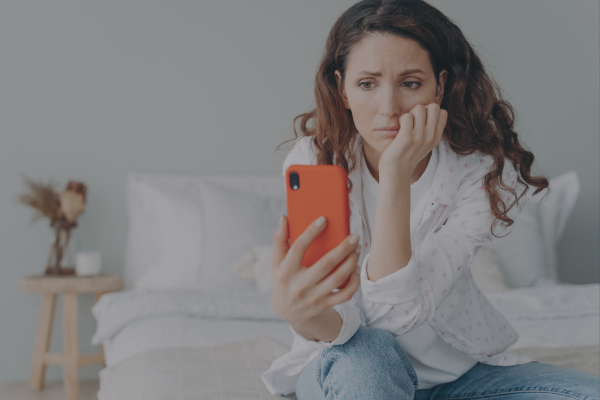Distraction For Anxiety: Does It Work?
“When I panic, I have to scroll through Instagram to distract myself!”
Distraction is one of the most popular “techniques” for getting away from high anxiety, panic, and any thoughts or sensations that people hate or fear. It’s talked about all the time. A quick look on social media would likely reveal many many posts about “tips for anxiety” that are based primarily on distraction techniques. Distraction – in the moment – can often bring some quick relief. Not always, but in many cases people find that it they run to a distraction to escape from anxious feelings and thoughts, then can feel better. But does distraction actually “work” in the context of real recovery, or is it just a band-aid you use to get you through one anxious moment so you can fear the next anxious moment and do it all again?
You can distract to save yourself, or you can distract to learn that you don’t need to distract after all. Choose wisely.
Are You Subscribed To My Newsletter? Recovery tips. Updates on recovery resources. Encouragement. Inspiration. Empowerment. All delivered to your inbox! Subscribe here FREE. More Ways To Listen/Watch My Podcast: Listen on Apple Podcasts | Listen on Spotify | Listen on Amazon Music | Watch on YouTube Helpful Recovery Resources: My Books | FREE Resources | Courses and Workshops | Disordered (with Josh Fletcher)

THE HIGHLIGHTS
- Distracting oneself when anxious often “works”. If you’ve ever said that you would be OK if you could just “get out of your head”, then you might use distraction to calm you down and make you feel better when experiencing moments of high anxiety, discomfort, or distress.
- Sometimes the attempt to distract as a way to calm down doesn’t work and it backfires, fueling an even higher level of fear or distress when you can’t instantly knock down your anxiety or fear.
- Often, however, distraction does bring some measure of temporary relief. This is true. There’s a ton of good research on this topic that’s been done over many years.
- Of particular note is the kind of distraction fueled by the electronic devices we all carry around all day. Burying one’s head in a phone or tablet to “comfort scroll” as a distraction might help in the moment but can contribute to eye and vision problems, muscle tension issues in the neck and shoulders, and might exacerbate things like balance problems or feelings of derealization or depersonalization.
- While distraction might make you feel better in the moment and for a short while, distraction used an intentional way to run, escape, be saved from anxiety, or avoid anxiety, will become an obstacle to actual recovery. Why is this?
- When we frantically attempt to distract specifically to get away from, drown out, or knock down internal experiences that we hate and fear, we are repetitively confirming our belief that those things are dangerous, un-handlable, disastrous, and worthy of special urgent evasive action. We are proving to ourselves that we are inacapable of tolerating fear or discomfort and that we can only be OK if we can run away from them and be saved from them.
- This leads to a never ending cycle where you fear your own body and mind, run away with distraction every time you feel things you fear or dislike, and remain convinced that escaping, avoiding and running are your only choices. Distraction puts a band-aid on distress and discomfort that gets ripped off again and again, requiring an ever greater supply of band-aids to “get you through” those anxious moment.
- Distraction does deliver us a valuable lesson about the irrational and misguided nature of our anxiety and fear, however when we use it as an escape or safety tool we completely ignore that lesson and instead conclude that we “made it” through anxiety and fear because we ran.
- Useful distraction – which I tend to reframe as refocus or purposeful engagement outside yourself – is what we get when we get into things with a willingness to fully face the feelings and experiences we fear. We must be willing to let those feelings rise, peak, then fall on their own without bracing, resisting, or being rescued from them. This willingness takes some time to cultivate so be patient with yourself if you’re not there yet.
- That new willingness to face, accept, surrender, tolerate, or float means that we use the mechanics of distraction or re-engagement in a productive way. We re-focus, re-engage, and “distract” with the intent of still feeling all the things and allowing them to play out without resistance.
- We “distract” with things not designed to save us, but with things that we value and are naturally drawn to.
- This new form of distraction based on willingness and a new intention teaches us that we are capable of navigating through our distress, discomfort, anxiety and fear.
- This kind of “distraction” – which takes a while to develop – is more than a band-aid. It leads us down the path of a more lasting and durable recovery.
- Remember, you will not instantly change your distraction techniques just by listening to this podcast episode. This shift takes time and practice and repetition. Be kind to yourself and be patient with yourself while you work on this.
Are You Subscribed To My Newsletter?
Recovery tips. Updates on recovery resources. Encouragement. Inspiration. Empowerment. All delivered to your inbox! Subscribe here FREE.
Helpful Recovery Resources:
My Books | FREE Resources | Courses and Workshops | Disordered (with Josh Fletcher) | Join My Instagram Subscriber Group
Podcast Intro/Outro Music: "Afterglow" by Ben Drake (With Permission)
